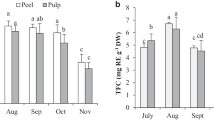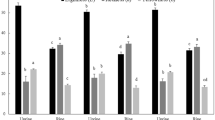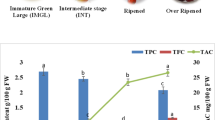Abstract
The changes in bioactive molecules (capsaicin, total phenol, total flavonoid, ascorbic acid and β-carotene) and antioxidant potential in Capsicum chinense Jacq. cv. Habanero were examined during nine maturity stages (at 7-day interval from fruit set). The rate of in vivo synthesis of these antioxidants increased progressively with advancing maturity. Capsaicin, ascorbic acid, and β-carotene contents increased about 3, 10, and 9 times, respectively, at 63 days after fruit set (DAFS) while the highest value for total phenol (~330 mg CE/100 g), flavonoid (~138 mg RE/100 g), DPPH radical scavenging activity (~82 %), and metal chelating activity (~75 %) recorded in 42–49 DAFS. Bioactive molecules were positively correlated with radical scavenging and metal chelating activities. The results underline the effect of maturity on the bioactive molecules and antioxidant potential suggesting that fruits at the red stage (42–49 DAFS) are optimal from the nutritional point of view.




Similar content being viewed by others
References
Adedayo BC, Oboh G, Akindahunsi AA (2010) Changes in the total phenol content and antioxidant properties of pepper fruit (Dennettia tripetala) with ripening. Afr J Food Sci 4:403–409
Alvarez-Parrilla E, de la Rosa L, Amarowicz R, Shahidi F (2011) Antioxidant activity of fresh and processed Jalapeno and Serrano peppers. J Agric Food Chem 59:163–173
AOAC (1990) Official methods of analysis, 5th edn. Association of Official Analytical Chemists, Arlington
Bae H, Jayaprakasha GK, Jifon J, Patil BS (2012) Variation of antioxidant activity and the levels of bioactive compounds in lipophilic and hydrophilic extracts from hot pepper (Capsicum spp.) cultivars. Food Chem. doi:10.1016/j.foodchem.2012.03.108 (in press)
Brand-Williams W, Cuvelier ME, Berset C (1995) Use of a free radical method to evaluate antioxidant activity. LWT Food Sci Technol 28:25–30
Conforti F, Statti GA, Menichini F (2007) Chemical and biological variability of hot pepper fruits (Capsicum annuum var. acuminatum L.) in relation to maturity stage. Food Chem 102:1096–1104
Deepa N, Kaur C, George B, Singh B, Kapoor HC (2007) Antioxidant constituents in some sweet pepper (Capsicum annuum L.) genotypes during maturity. LWT Food Sci Technol 40:121–129
Ebrahimzadeh MA, Pourmorad F, Bekhradnia AR (2008) Iron chelating activity screening, phenol and flavonoid content of some medicinal plants from Iran. Afr J Biotechnol 32:43–49
Elbadrawy E, Sello A (2012) Evaluation of nutritional value and antioxidant activity of tomato peel extracts. Arabian J Chem. doi:10.1016/j.arabjc.2011.11.011 (in press)
Henderson DE, Slickman AM, Henderson SK (1999) Quantitative HPLC determination of the antioxidant activity of capsaicin on the formation of lipid hydroperoxides of linoleic acid: a comparative study against BHT and melatonin. J Agric Food Chem 47:2563–2570
Howard LR, Talcott ST, Brenes CH, Villalon B (2000) Changes in phytochemical and antioxidant activity of selected pepper cultivars (Capsicum species) as influenced by maturity. J Agric Food Chem 48:1713–1720
Ilahy R, Hdider C, Lenucci MS, Tlili I, Dalessandro G (2011) Antioxidant activity and bioactive compound changes during fruit ripening of high-lycopene tomato cultivars. J Food Compos Anal 24:588–595
Jimenez M, Garcia-Carmona F (1999) Oxidation of the flavonol quercetin by polyphenol oxidase. J Agric Food Chem 47:56–60
Koley TK, Kaur C, Nagal S, Walia S, Jaggi S (2011) Antioxidant activity and phenolic content in genotypes of Indian jujube (Zizyphus mauritiana Lamk.). Arabian J Chem. doi:10.1016/j.arabjc.2011.11.005 (in press)
Marín A, Ferrerei F, Tomás-Barberán FA, Gill MI (2004) Characterization and quantization of antioxidant constituents of sweet pepper (Capsicum annuum L.). J Agric Food Chem 52:3861–3869
Martinez S, Mercedes L, Gonzalen-Raurich M, Alvarez AB (2005) The effects of ripening stage and processing systems on vitamin C content in sweet peppers (Capsicum annuum L.). Int J Food Sci Nutr 56:45–51
Materska M, Perucka I (2005) Antioxidant activity of the main phenolic compounds isolated from hot pepper fruit (Capsicum annuum L.). J Agric Food Chem 53:1750–1756
Menichini F, Tundis R, Bonesi M, Loizzo MR, Conforti F, Statti G, Cindio BD, Houghton PJ, Menichini F (2009) The influence of fruit ripening on the phytochemical content and biological activity of Capsicum chinense Jacq. cv Habanero. Food Chem 114:553–560
Navarro JM, Flores P, Garrido C, Martinez V (2006) Changes in the contents of antioxidant compounds in pepper fruits at different ripening stages, as affected by salinity. Food Chem 96:66–73
Oboh G, Rocha JBT (2008) Water extractable phytochemicals from Capsicum pubescens (tree pepper) inhibit lipid peroxidation induced by different pro-oxidant agents in brain: in vitro. Eur Food Res Technol 226:707–713
Oboh G, Puntel RL, Rocha JBT (2007) Hot pepper (Capsicum annuum, Tepin and Capsicum chinese, Habanero) prevents Fe2+-induced lipid peroxidation in brain: in vitro. Food Chem 102:178–185
Pino J, Sauri-Duch E, Marbot R (2006) Changes in volatile compounds of Habanero chili pepper (Capsicum chinense Jack. cv. Habanero) at two ripening stages. Food Chem 94:394–398
Raganna S (2006) Handbook of analysis and quality control for fruit and vegetable products. Tata McGraw-Hill Publication, New Delhi
Russo VM, Howard LR (2002) Carotenoids in pungent and non-pungent peppers at various developmental stages grown in the field and glass house. J Sci Food Agric 82:614–615
Sadasivam S, Manickam A (1997) Biochemical methods for agricultural sciences. Wiley Eastern Ltd., New Delhi
Siddiqui MW, Chakraborty I, Ayala-Zavala JF, Dhua RS (2011) Advances in minimal processing of fruits and vegetables: a review. J Sci Ind Res 70(9):823–834
Siddiqui MW, Ayala-Zavala JF, Dhua RS (2012) Genotypic variation in tomatoes affecting processing and antioxidant attributes. Crit Rev Food Sci Nutr. doi:10.1080/10408398.2012.710278 (in press)
Singleton VL, Orthofer R, Lamuela-Raventos RM (1999) Analysis of total phenols and other oxidation substrates and antioxidants by means of Folin–Ciocalteau reagent. Methods Enzymol 299:152–178
Tapiero H, Townsend DM, Tew KD (2004) The role of carotenoids in the prevention of human pathologies. Biomed Pharmacother 58:100–110
Zewdie Y, Bosland PW (2000) Evaluation of genotype, environment, and genotype-by-environment interaction for capsaicinoids in Capsicum annuum L. Euphytica 111:185–190
Zhishen J, Mengcheng T, Jianming W (1999) The determination of flavonoid contents in mulberry and their scavenging effects on superoxide radicals. Food Chem 64:555–559
Author information
Authors and Affiliations
Corresponding author
Additional information
Communicated by E. Kuzniak-Gebarowska.
Rights and permissions
About this article
Cite this article
Siddiqui, M.W., Momin, C.M., Acharya, P. et al. Dynamics of changes in bioactive molecules and antioxidant potential of Capsicum chinense Jacq. cv. Habanero at nine maturity stages. Acta Physiol Plant 35, 1141–1148 (2013). https://doi.org/10.1007/s11738-012-1152-2
Received:
Revised:
Accepted:
Published:
Issue Date:
DOI: https://doi.org/10.1007/s11738-012-1152-2




